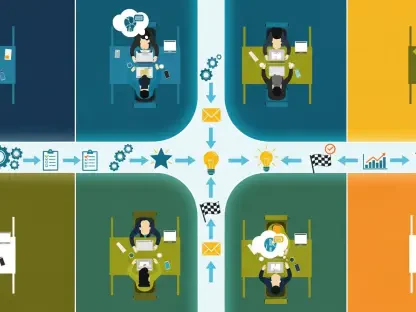The modern workforce landscape is undergoing a profound transformation as artificial intelligence (AI) redefines the very nature of work. Once seen merely as supplementary tools, AI technologies are now emerging as pivotal digital teammates capable of executing a myriad of tasks traditionally reserved for humans. This shift is reshaping the definition of a qualified workforce, with AI agents expanding the potential scope of digital labor markets to unprecedented levels. Industry leaders estimate that the value of this digital labor market could climb into the trillions, fundamentally altering how businesses conceive and structure their operations.
Rethinking Workforce Composition
The Integration of AI and Human Collaboration
In recent years, AI has evolved beyond simple automation to become an integral partner in various professional settings, bringing forth new opportunities for collaboration between AI and human workers. Prestigious institutions, including Harvard Business School and the Digital Data Design Institute, have noted the expanding roles of AI in fostering a collaborative workforce. By lending scalability, resilience, and increased productivity, AI has not only augmented human capabilities but has also prompted industries to rethink traditional workforce dynamics. Enterprises are participating actively in this transformation. Organizations like Deloitte have incorporated AI across numerous functions, utilizing intelligent marketing agents to enhance customer interactions efficiently. Such collaboration reflects a larger trend where AI plays a transformative role, pushing companies to blend human creativity with machine precision to achieve strategic objectives.
Pioneering Hybrid Labor Models
Forward-thinking corporations and staffing agencies spearhead the integration of AI by developing hybrid labor models. These innovative approaches blend human talent with AI capabilities in a manner that maximizes efficiency and productivity. Staffing firms like rPotential exemplify this by emerging as pioneers in establishing hybrid models, seamlessly integrating AI into team structures. This model allows for the optimization of talent resources, capturing the diverse benefits AI can offer while maintaining essential human oversight. These integrations foster new paradigms where human comprehension and AI efficiency go hand in hand, allowing businesses to stay competitive in an increasingly digital landscape. Establishing hybrid models includes cultivating AI-human synergy, which demands a careful balance of responsibilities and an understanding of each party’s strengths.
Strategic Foresight in AI Adoption
Managing AI Integration Within Enterprises
Navigating AI integration requires a strategic framework defined by clarity in tasks and roles. Developing such a framework involves dissecting organizational roles into fundamental tasks, determining which tasks are better suited for AI, and creating an internal roadmap for integration. Tailoring AI capabilities to align with organizational workflows aids in adopting an effective, customized approach. By avoiding a one-size-fits-all methodology, organizations can ensure targeted AI deployment that meets specific business needs. Companies must pursue procurement efforts with diligence through well-crafted requests for proposals (RFPs), selecting vendors demonstrating expertise in their domains. This meticulous organization in AI integration helps avoid potential pitfalls and ensures successful adoption.
Ensuring Compliance and Mitigating Risks
Strategic foresight in AI deployment involves addressing potential risks linked to new technology. Proactive risk management requires setting comprehensive guidelines regarding data usage, ensuring compliance with international regulations, and addressing issues such as AI bias and data governance. Collaboration with legal and compliance teams is crucial in this aspect, facilitating the creation of ethical standards and policies to avoid public relations crises and legal liabilities. By establishing robust oversight mechanisms, organizations are better equipped to control AI’s dynamic nature through iterative improvement rather than preset models. Ensuring dedicated resources monitor AI performance and influence, organizations can maintain control over these technologies, enabling them to better capture emergent opportunities.
Talent Development and Ethical Considerations
Enhancing Human Skills in an AI-Driven World
AI’s influence on the labor market underscores the importance of enhancing human skills to complement technological efficiencies. As AI assumes more routine tasks, human workers are free to focus on high-value activities requiring creativity, empathy, and ethical decision-making. Organizations are encouraged to foster continuous learning environments that encourage skill development essential for thriving in AI-augmented settings. Investing in training programs centered around creativity and interpersonal skills ensures employees contribute uniquely, maintaining an organization’s competitive advantage. This balance between AI efficiency and human insight supports a more adaptable workforce, capable of meeting new challenges presented by evolving market demands.
Addressing Ethical Challenges in AI Implementation
An important aspect of integrating AI into the workforce is addressing its ethical implications. Organizations must navigate a landscape where AI’s impact on personal privacy, bias, and societal roles presents complex challenges. Ethical frameworks should reflect a commitment to transparency, fairness, and accountability in AI usage. As regulatory landscapes develop rapidly, companies need to align their practices with emerging laws and standards, ensuring AI’s societal benefits are maximized while mitigating potential harm. Initiatives aimed at developing ethical guidelines for AI are vital, reflecting an understanding of the dynamic interplay between technological innovation and social responsibility, which anchors AI’s role as a transformative force.
Setting the Stage for Future Workforce Dynamics
Guiding Principles for AI Strategy Development
Developing a successful AI strategy requires focusing on essential aspects like data ownership, regulatory compliance, and liability in errors resulting from AI operations. Organizations must assess AI’s implications on job roles and redefine tasks accordingly, particularly as AI agents continue gaining influence. These guiding principles are less about immediate solutions and more about framing ongoing strategic dialogues. Organizations actively engaging in these conversations are better positioned to shape the future of labor markets, ensuring that AI’s integration is beneficial at a technological and human level.
Balancing Technological Efficiency with Human Insight
The landscape of today’s workforce is experiencing a significant transformation as artificial intelligence (AI) alters the essence of work itself. Previously regarded as mere supplements to human efforts, AI technologies have now evolved into integral digital teammates, adept at executing numerous tasks that were traditionally the domain of human workers. This evolution is redefining what constitutes a qualified workforce, as AI agents substantially broaden the range of digital labor markets to levels never before seen. According to industry leaders, the value tied to this burgeoning digital labor market could soar into the trillions. As a result, businesses must rethink and restructure how they perceive and organize their operations. As AI continues to advance, these technologies promise to revolutionize industries across the board, increasing efficiency and productivity, and consequently altering employment dynamics on a global scale. Companies now face new challenges, including the integration of AI systems alongside human teams, addressing ethical concerns, and ensuring the workforce adapts to a rapidly changing digital environment. The shift toward AI-centric work environments embodies a fundamental change in how labor is conceptualized, managed, and utilized in the modern world.









